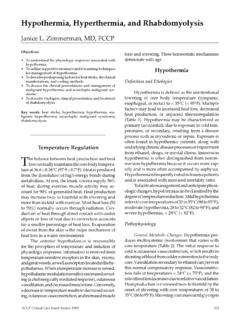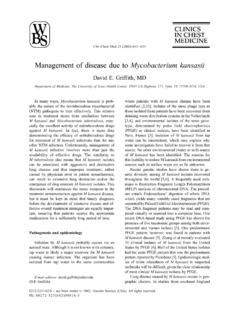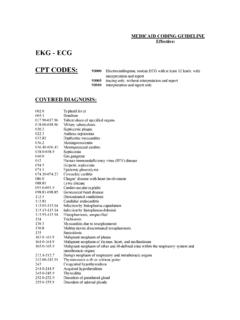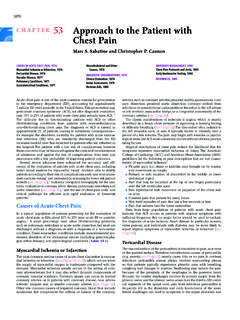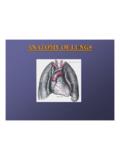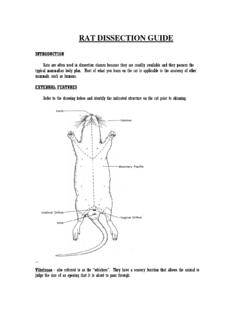Transcription of STAGING CLASSIFICATION OF LUNG CANCER - …
1 LUNG CANCER 0272 5231/02 $ .00. STAGING CLASSIFICATION OF. LUNG CANCER . A Critical Evaluation Clifton F. Mountain, MD. In patients with lung CANCER , the relationship adoption by the American Joint Committee on between the anatomic extent of the disease at diag- CANCER (AJCC) and the International Union nosis and survival duration is well known. This Against CANCER (UICC) in , 23, 25 Box 1 and relationship is the basis for the STAGING concept. Table 1 document the de nitions and the stage Many host and tumor characteristics have been grouping of the TNM subsets. The system is appli- investigated for their in uence on prognosis in this cable for the four major cell types of lung CANCER : disease5, 9, 13, 19, 20, 42, 44; however, end results studies adenocarcinoma, squamous cell carcinoma, large according to components of the International Sys- cell carcinoma, and small cell carcinoma.
2 Clinical tem for STAGING Lung CANCER , the TNM factors (T- STAGING , cTNM-cStage, is based on all diagnostic primary tumor, N-regional lymph nodes, M-dis- and evaluative information obtained before the tant metastasis), and the stage group remain benchmarks for estimating prognosis, entering pa- tients into clinical trials, comparing differing treat- ments, and evaluating new prognostic factors. The Table 1. TNM (TUMOR, REGIONAL LYMPH NODES, consistent, reproducible de nitions provide the METASTASIS) BY STAGE*. means for universal communication about the sta- Stage TNM Subset tus of treatment for speci c groups of patients. These tenets are con rmed in the most recent texts 0 Carcinoma in situ on the diagnosis and treatment of lung CANCER ; IA T1 N0 M0.
3 Their organization of content according to STAGING IB T2 N0 M0. components describes clinical evaluations and rec- IIA T1 N1 M0. IIB T2 N1 M0. ommendations for therapy in these , 46 The T3 N0 M0. STAGING system as an effective vehicle for commu- IIIA T3 N1 M0. nicating new knowledge about lung CANCER also is T1 N2 M0. revealed in the national and international medical T2 N2 M0. , 7, 16, 26, 29, 53 T3 N2 M0. IIIB T4 N0 M0 T4 N1 M0. T4 N2 M0. T1 N3 M0 T2 N3 M0. THE INTERNATIONAL SYSTEM FOR T3 N3 M0 T4 N3 M0. STAGING LUNG CANCER IV Any T Any N M1. * STAGING is not relevant for occult carcinoma, designated TX. The International System for STAGING Lung Can- N0 M0. From Mountain CF: Revisions in the International STAGING cer 38 has had widespread application since its System for Lung CANCER .
4 Chest III 1712, 1997; with permission. From the Department of Cardiothoracic Surgery, The University of California at San Diego, San Diego, California CLINICS IN CHEST MEDICINE. VOLUME 23 NUMBER 1 MARCH 2002 103. 104 MOUNTAIN. Box 1. TNM (Tumor, Regional Lymph Nodes, Metastasis) Descriptors Primary Tumor (T). TX Primary tumor cannot be assessed or tumor proved by the presence of malignant cells in sputum or bronchial washings but not visualized by imaging or bronchoscopy T0 No evidence of primary tumor Tis Carcinoma in situ T1 Tumor 3 cm or less in greatest dimension, surrounded by lung or visceral pleura, without bronchoscopic evidence of invasion more proximal than the lobar bronchus* ( , not in the main bronchus).
5 T2 Tumor with any of the following features of size or extent: More than 3 cm in greatest dimension Involves main bronchus, 2 cm or more distal to the carina Invades the visceral pleura Associated with atelectasis or obstructive pneumonitis that extends to the hilar region but does not involve the entire lung T3 Tumor of any size that directly invades any of the following: chest wall (including superior sulcus tumors), diaphragm, mediastinal pleura, or parietal pericardium; or tumor in the main bronchus less than 2 cm distal to the carina but without involvement of the carina; or associated atelectasis or obstructive pneumonitis of the entire lung T4 Tumor of any size that invades any of the following: mediastinum, heart, great vessels, trachea, esophagus, vertebral body, or carina; or tumor with a malignant pleural or pericardial effusion.
6 Or with satellite tumor nodule(s) within the ipsilateral primary tumor lobe of the lung Regional Lymph Nodes (N). NX Regional lymph nodes cannot be assessed N0 No regional lymph node metastasis N1 Metastasis to ipsilateral peribronchial and/or ipsilateral hilar lymph nodes and intrapulmonary nodes involved by direct extension of the primary tumor N2 Metastasis to ipsilateral mediastinal and/or subcarinal lymph node(s). N3 Metastasis to contralateral mediastinal, contralateral hilar, ipsilateral or contralateral scalene, or supraclavicular lymph node(s). Distant Metastasis (M). MX Presence of distant metastasis cannot be assessed M0 No distant metastasis M1 Distant metastasis present.
7 Specify sites *T1: The uncommon super cial tumor of any size with its invasive component limited to the main bronchus is classi ed as T1. T4: Most pleural effusions associated with lung CANCER are caused by tumor. There are, however, a few patients in whom cytopathologic examination of pleural uid (on more than one specimen) is negative for tumor, the uid is nonbloody, and is not an exudate. In such cases in which these elements and clinical judgment dictate that the effusion is not related to the tumor, the patients should be staged T1, T2, or T3, excluding effusion as a STAGING element. M1: Separate metastatic tumor nodule(s) in the ipsilateral nonprimary tumor lobe(s) of the lung also are classi ed M1.
8 From Mountain CF: Revisions in the International System For STAGING Lung CANCER . Chest 111:1711, 1997; with permission. start of treatment, including the results of invasive pathologic examination of resected specimens. In procedures, such as bronchoscopy, needle biopsy, Figure 3, survival data according to pStage re ect mediastinoscopy, and diagnostic thoracoscopy. The the more accurate evaluation of disease extent that clinical stage is assigned to each patient and is not is available from surgical pathologic data. The op- changed throughout the course of the disease. The tions for de nitive treatment and survival patterns importance of the clinical classi cation cannot be are related to pStage factors.
9 A retreatment classi- overemphasized because this information is corre- cation, rTNM-rStage, is useful for assessing the lated with end results studies to serve as a guide ef cacy of the rst step in multistep treatment for treatment planning. The survival data in Fig- plans. For example, protocols of induction therapy ures 1 and 2 demonstrate that clinical STAGING may use the rTNM-rStage as criteria for assigning groups patients according to measurable anatomic or randomizing patients to subsequent treatments. features of their disease that are relevant to treat- The use of identical de nitions for each type of ment options and prognosis. classi cation is essential; elements that can be de- The classi cation schema also is useful for surgi- termined only from surgical specimens are not in- cal pathologic STAGING , pTNM-pStage, based on cluded in the schema.
10 STAGING CLASSIFICATION OF LUNG CANCER 105. Figure 1. Cumulative proportion of patients with non small cell lung carcinoma expected to survive 5 years according to clinical stage. Number of patients: cIA, n 675; cIB, n . 1130; cIIA, n 26; cIIB, n 329; cIIIA, n 445; cIIIB, n . 836; cIV, n 1166. Overall comparison: P .05. Pairwise comparison: cIA versus cIB, P .05; cIB versus cIIA, P ..05; cIIA versus cIIB, P .05; cIIB versus cIIIA, P .05; cIIIA. versus cIIIB, P .05; cIIIB versus cIV, P .05. (From Moun- tain CF, Libshitz HI, Hermes KE: Lung CANCER . A Handbook for STAGING , Imaging and Lymph Node Classi cation. Houston, Mountain and Libshitz, 1999, p 65; with permission.). 106 MOUNTAIN.
